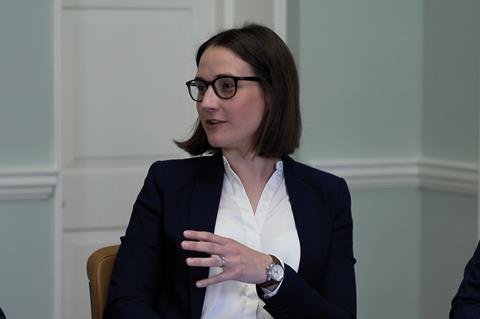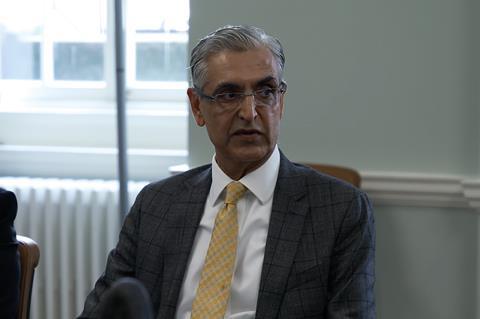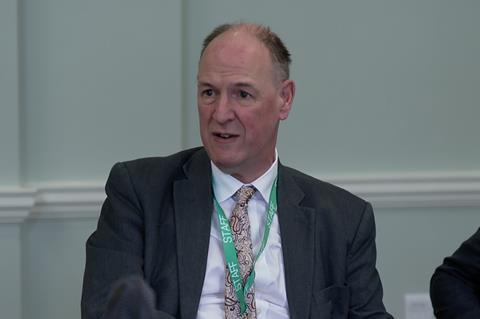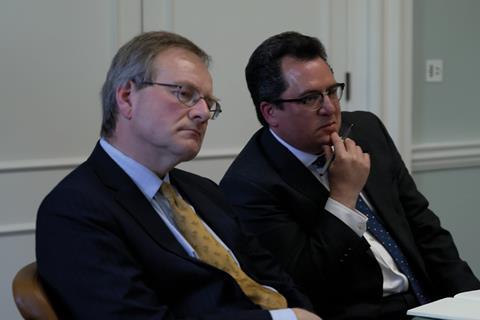Legislation that made sweeping cuts to civil legal aid and ushered in the controversial Jackson reforms came into force a decade ago, with far-reaching consequences for personal injury and medical negligence cases in particular. So where are we now? Eduardo Reyes reports from the latest Gazette roundtable

At the table (left, clockwise)
Eduardo Reyes, The Law Society Gazette (chair)
Sharon Allison, Ashtons, SCIL
John McQuater, Switalskis, APIL
David Haynes, ARAG plc
Nicola Critchley, DWF, FOIL
Richard Miller, The Law Society
Ben Collins KC, Old Square Chambers
Beth Heath, Lanyon Bowdler
John Hyde, The Law Society Gazette
Gillian Gadsby, Gadsby Wicks
Catherine Bennett, Capsticks
Anne Kavanagh, Irwin Mitchell
Krishna Kotecha, Moosa Duke
Vinod Kathuria, TULA Medical Experts
Paul Rumley, RWK Goodman, SCIL
Richard Geraghty, Irwin Mitchell
Emily Formby KC, 39 Essex Chambers, PIBA
Malcolm Johnson, Lime Solicitors
The Legal Aid, Sentencing and Punishment of Offenders Act has a significant birthday this year. It is 10 years since the 2012 legislation came into force, with huge consequences for civil justice. Personal injury and clinical negligence cases were among those that lost most public funding, which was cut through part 1 of the act. Those cuts went hand in hand with reforms of civil justice based on a review and report by Sir Rupert Jackson.
The Jackson reforms ended the recoverability of the ‘success fee’ that attached to conditional fee agreements, meaning it was no longer among the costs that could be recouped from a losing defendant. The reforms also enhanced the importance of case management and costs budgeting by placing discussions and agreements relating to both elements close to the start of a case’s conduct. Meanwhile, the principle of ‘qualified one-way costs shifting’ (QOCS) provided some protection for claimants against an adverse result. That principle has since been eroded.
Access to justice
The loss of legal aid for most personal injury and clinical negligence cases is lamented by claimant lawyers and campaign groups, but law firms have adapted and continued to represent clients in such cases. Sharon Allinson, partner at Ashtons and vice chair of the Society of Clinical Injury Lawyers (SCIL), begins: ‘In terms of the impact on access to justice, I’m of the opinion that we adapted with our clients and we’ve worked quite closely with third-party providers in order to continue to provide that access to justice… it is very much business as usual.’
The availability of insurance products has had an effect, ensuring representation levels have remained high in personal injury cases. David Haynes, underwriting director at ARAG, says: ‘I know that we’ve stepped in… [insurance] can fill that void around access to justice, because without a doubt it’s only going one way.’ He points out that the expectation following the government’s ‘whiplash’ reforms was that claimants would choose to claim without representation. Instead, he notes, 91% are still represented.
That said, LASPO inhibited the ability of firms to take on some cases. ‘I would say that we’re perhaps taking a stricter approach to our screening process,’ says Beth Heath, partner and head of clinical negligence at Lanyon Bowdler. ‘Our numbers suggest that, with proportionality and cost-benefit analysis, perhaps we are being a bit more stringent.’
That does not necessarily mean that claimants are refraining from bringing claims – but such claims are brought without representation. ‘One thing we’ve seen, particularly over the past five or six years, is an increase in litigants in person,’ says Catherine Bennett, partner at Capsticks. The firm, which acts for health sector clients in clinical negligence cases, therefore sees ‘very challenging claims from litigants in person and unmeritorious claims’. With proper legal advice, she stresses, such claims would be less likely to proceed.
'We’re perhaps taking a stricter approach to our screening process. Our numbers suggest that, with proportionality and cost-benefit analysis, perhaps we are being a bit more stringent'
Beth Heath, Lanyon Bowdler
LIPs are among several problems the courts face in progressing cases, Personal Injury Bar Association (PIBA) chair Emily Formby KC notes: ‘There are terrible problems in getting listed at the moment. Injury claims tend to get listed in blocks and we all know the consequences of having four or five trials listed on one day… the first one’s a litigant in person and then you really know that’s the end of it for everyone for that day.
‘The other problem is that [LIPs] are spreading into other arenas. Injury gets knocked down the pecking order of court cases. We all know there are real problems with listings due to other, more urgent cases, such as family or care cases being put in ahead. The consequences for justice are much wider than the immediate business field. Ancillary cost and delay impact us all.’
To bring claims with representation, clients use before- or after-the-event insurance to cover the risk of losing their claim. As with any ‘success fee’ that firms charge, this cannot now be recouped from a losing defendant by a winning claimant. Together with the success fee, that cost is the ‘skin in the game’ introduced by government ministers preoccupied with the need to suppress an alleged ‘compensation culture’.

John McQuater, president of the Association of Personal Injury Lawyers and joint head of the personal injury department at Switalskis, says: ‘The concept, if I remember rightly, was drawing a parallel with commercial cases. If you have two commercial parties litigating, these kinds of considerations are important. Of course, that completely misses the point for the type of case we’re talking about… one of the features of PI and clinical negligence litigation is you have one party who’s not experienced in litigation.’
‘I’ve never had clients come to me just to “have a go”,’ says Gillian Gadsby, managing partner at Gadsby Wicks. ‘The people who come to us have got significant injuries even though not all of them sound like very much in damages. I think most of my clients are not really in it for the money. If you really wanted to pursue a claim that was unmeritorious, I don’t think you’d find a lawyer who could do it.’ Therefore, she asks: ‘Why do you have to have some “skin in the game”?’
This leads to a discussion on how the principle of ‘restitution’ – the idea that a monetary settlement should restore a victim to their previous position – plays out in personal injury and clinical negligence cases. After all, these sums are deducted from the assessed needs of a successful claimant.
Krishna Kotecha, CEO at Moosa Duke, says: ‘Even if you leave aside the question of costs, obviously you’ve got the success fee, you’ve got the insurance premium, disbursements, interest, admin fees. All of that is going to be taken away from the damages… 100% restitution is just not possible. Even with everything going perfectly and in your favour.’
Is restitution even the right principle? ‘I’m not sure that restitution is possible, frankly, in any cases of mine,’ says Anne Kavanagh, a clinical negligence partner at Irwin Mitchell. ‘I think the best you can hope for is rehabilitation and support. That requires compensation which allows that family, that child usually, to live a life where they can be supported and enjoy their family life and their parents are not... worried about what will happen when they can no longer care for their child.
‘I’m not sure that restitution is always the right objective in medical negligence. We do really focus on rehabilitation; by definition our clients are severely injured and recovery is not always possible.’

Expert evidence
Legal aid is still available for some clinical negligence cases. A baby who has suffered a severe brain injury during pregnancy or during or shortly after birth can qualify. If a case is deemed ‘exceptional’ by the director of legal aid case work, then funding will also be available.
But the low rates paid for experts are affecting such cases. Vinod Kathuria (pictured), orthopaedic consultant and medical director at TULA Medical Experts, warns: ‘With legal aid rates that haven’t changed for so many years, it’s difficult to find the right experts who are experienced and willing to work for those rates. There are some old-school consultants who take the social responsibility and who do these cases for the rates provided. But that pool is shrinking rapidly.’

In the absence of an increase in rates, Kathuria says: ‘You can talk to people, you can try and reason it out and try to remind them of their social responsibilities and the responsible position that they’re in.’ They are also, he notes, working under enormous pressure as junior consultants.
Richard Miller, the Law Society’s head of justice policy, adds that student debt may now play a part in experts’ willingness to give evidence at legal aid rates: ‘I’ve often speculated that when education was free, professionals in that position would feel, “Society has given me something, I want to give something back”.’ Their level of personal financial debt, he speculates, may have weakened that former sense of obligation.
Nevertheless, Old Square Chambers silk Ben Collins notes: ‘Any judgment from the appellate courts which is about damages always starts with this concept that the purpose of the claim is to ensure that you have 100% compensation. That is, the claimant should have no more and no less than they need to put them back in the position that they would have been in, excepting of course that an injury is something that can’t be healed, and we’re only ever talking about money.’
Cost decisions then occur ‘largely in a vacuum’, he notes. Add in Part 36 offers and other elements of the costs regime intended to shape litigants’ behaviour and decisions, and ‘you’re not talking about the case anymore’, Collins adds. This adds to the impression, for a claimant, that litigation is a ‘game… a dance’.
Does the regime work from a defendant perspective? DWF partner Nicola Critchley, president of the Forum of Insurance Lawyers (FOIL), welcomes the government’s decision to remove the full protection offered by QOCS earlier this year, which increases a claimant’s incentive to settle. She also notes: ‘In the higher-value claims, the ones that we deal with, a small fraction of cases go to court. They are settled and they are settled by JSMs [joint settlement meetings].’
The Law Society’s head of justice policy Richard Miller says: ‘There is an absolutely legitimate point that defendants were in a position where there was no penalty to a claimant for unreasonably failing to accept a Part 36 offer. I think it was right that this had to be addressed.’ However, he adds: ‘The change that’s been introduced as a result effectively drives a coach and horses through the protection of QOCS.’ The result, Miller argues, is that ‘the penalty is out of all proportion to any wrongdoing on [the claimant’s] part in not accepting the [Part 36] offer’.
Defendants can decide that they will not rely on the enhanced position that QOCS reforms have placed them in. As Heath relates: ‘The NHS, in a number of my cases, have been waiving their rights under the new QOCS changes.’
'The change that’s been introduced as a result effectively drives a coach and horses through the protection of QOCS… the penalty is out of all proportion to any wrongdoing on [the claimant’s] part in not accepting the [Part 36] offer'
Richard Miller, Law Society
Where compensation involves the payment of a lump sum, its size will be determined using the ‘discount rate’ – which is used to adjust an award to reflect what the sum might achieve if it is invested so as to provide sufficient funds to meet the claimant’s needs for the remainder of their lifetime.
‘If the last 10 years have told us anything, it’s that trying to predict what inflation and costs and everything else might do in the future is a mug’s game,’ Collins points out. Variables to take account of in recent years, he notes, have included ‘a financial crash, Brexit, a pandemic, monstrous inflation – and Liz Truss’.
The Ministry of Justice is currently consulting on the future of the discount rate. One proposal is the idea of a ‘dual discount rate’ that could apply different assumptions in the short- and long-term.

Allison says: ‘The difficulty we have with all of these different proposals is that these things are thrown out [there] with very little thought.’
‘When we look at a dual discount rate - I’ve seen no figures on that,’ is also an objection for RWK Goodman partner Paul Rumley, president of SCIL.
Irwin Mitchell partner Richard Geraghty notes that the dual discount rate ‘addresses issues about the length of time that someone has to invest money to pay for their needs and the degree of risk they can take’. But he adds: ‘At the same time it introduces a whole host of other complexities and problems, particularly how you calculate and quantify the claim. It is interesting that other jurisdictions that adopted it, such as Ontario, are now looking to move away from it. I’m not sure it’s the answer.’
Instead, he urges wider use of periodical payment orders (PPOs). ‘One way of ensuring that the compensation is closer to being appropriate is to use PPOs, so that there is no massive speculation about how long someone’s going to need this money for,’ Geraghty says. ‘It will pay for as long as it’s required.’ However, he adds: ‘PPOs seem to be declining in take-up rather that increasing.’
A key purpose of the Jackson reforms was to better control costs, and in that context to usher in a strong ‘proportionality’ principle. Costs should not seem excessive relative to the case’s value. Costs budgeting would therefore happen at the outset of a case and parties would find the agreed budgets linked to recoverability. Below a certain value (now raised to £100,000), fixed recoverable costs (FRCs) apply.

So how has this played out? On FRCs, Lime Solicitors senior consultant Malcolm Johnson says: ‘We found that, actually, fixed costs work for us.’
A specialist in child abuse cases, Johnson says that where there are multiple claims against an institution, it is possible to run claims through a ‘scheme’. If you have ‘a series of paralegals working on the case, you can actually make a profit’, he adds.
But while stricter costs budgeting may seem to favour defendants in personal injury cases, defendant solicitors are still critical. The Civil Justice Council held a consultation on costs last summer. Critchley says: ‘The FOIL response was to decouple the case management hearing from the budget hearing. The primary reason for that is that once you’ve got your directions established then it should be much more straightforward. First of all to do a budget, and secondly for the parties to reach agreement on the budget. It also reduces the burden on court time and that initial hearing when everything is determined.’
She also notes that while the budget can be reopened, it is rare to see such applications.
For higher-value cases, Johnson says the process has flaws. ‘The whole process of budgeting seems to be very rough and ready,’ he says. ‘I do wonder whether the problem is that the people who are actually making the decisions… not enough of them are solicitors. In my experience, barristers, wonderful though they are, don’t tend to deal with costs. That’s just not what they do.’
Collins replies: ‘Speaking as a barrister and a judge who does exactly what you’re talking about, the problem is that I don’t know enough about the mechanics of it within the solicitor’s firm. I don’t have enough time in the half an hour I’ve got to hear the parties and work out the right answer.’
'The whole process of budgeting seems to be very rough and ready. I do wonder whether the problem is that the people who are actually making the decisions… not enough of them are solicitors'
Malcolm Johnson, Lime Solicitors
Turning to the principle of proportionality, he observes: ‘The other significant problem is the proportionality test, because proportionality trumps necessity. And it may be that in order for the case to be heard properly, the costs which are required are disproportionate… But the judge’s hands are tied, because if you have to choose between proportionality and necessity, it’s proportionality that wins – and that eats away at the restitution principle as well.’

However, a focus on costs budgeting may mean some cases are better run. ‘I don’t think it’s a perfect system,’ Heath says. ‘But I think, as solicitors, we are now a lot more cost-aware. Our knowledge of costs is much better than it was 10 years ago. In a cost-driven world, that is a positive. Time-recording has also become more efficient, and again, there’s a lot more analysis [of] your time-recording than previously. There are some “pros” to be taken from costs budgeting.’
Personal injury and clinical negligence have witnessed huge changes in the past 25 years – LASPO being only the most recent major reform. When some in this group last met for a Gazette roundtable – on clinical negligence – government seemed to be moving behind the proposals of Jeremy Hunt, then chair of the health and social care committee, to remove medical claims to an ‘administrative body’.
Bennett says: ‘I think given the current political landscape, it’s all gone a little quiet, which is a good thing.’ The use of an ‘admin body’ would mean the loss of professional expertise, and, she argues, be a ‘crazy idea’. ‘I would hope very much that that is just quietly forgotten.’
- This roundtable discussion was kindly sponsored by ARAG plc and TULA Medical Experts


































1 Reader's comment